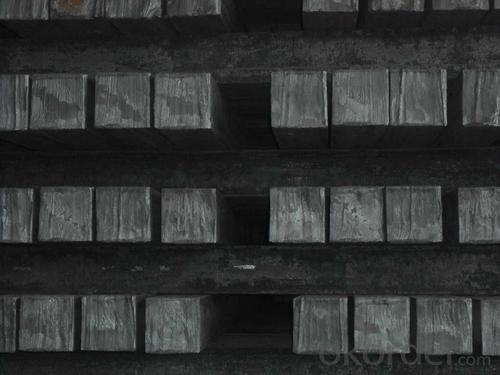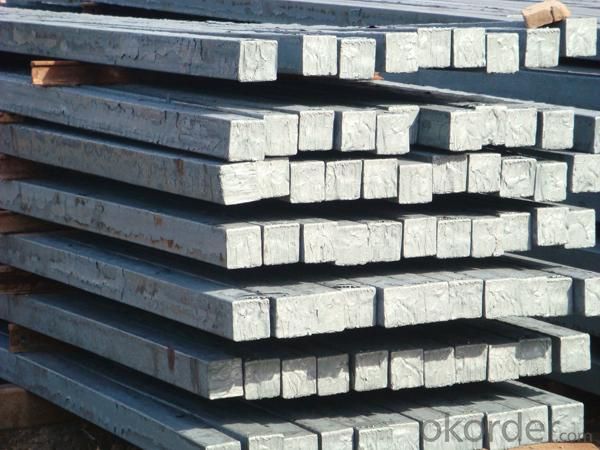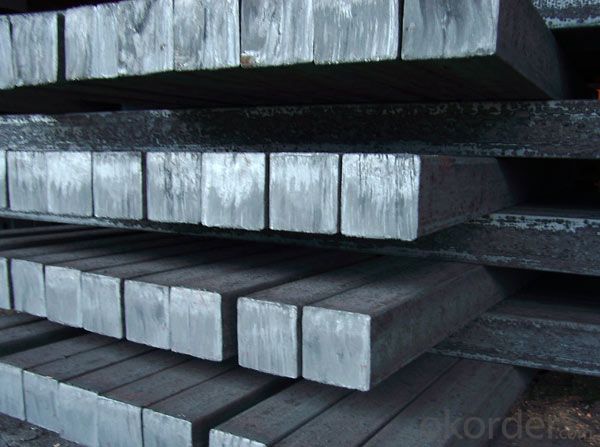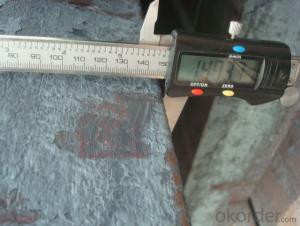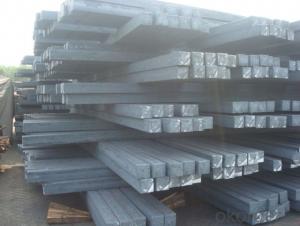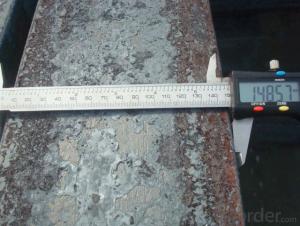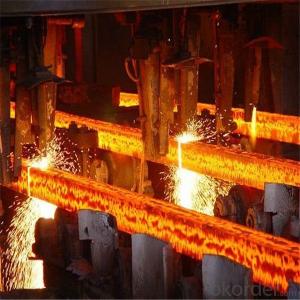Steel Billet Square with High Quality and Competitive Prices for Sale
- Loading Port:
- Tianjin
- Payment Terms:
- TT or LC
- Min Order Qty:
- 100 m.t.
- Supply Capability:
- 10000 m.t./month
OKorder Service Pledge
OKorder Financial Service
You Might Also Like
Product Description:
OKorder is offering Steel Billet Square with High Quality and Competitive Prices for Sale with worldwide shipping. Our supplier is a world-class manufacturer of steel, with our products utilized the world over. OKorder annually supplies products to European, North American and Asian markets. We provide quotations within 24 hours of receiving an inquiry and guarantee competitive prices.
Product Applications:
Steel Billet Square with High Quality and Competitive Prices for Sale are ideal for structural applications and are widely used in the construction of buildings and bridges, and the manufacturing, petrochemical, and transportation industries.
Product Advantages:
OKorder's Steel Billet Square with High Quality and Competitive Prices for Sale are durable, strong, and resist corrosion.
Main Product Features:
· Premium quality
· Prompt delivery & seaworthy packing (30 days after receiving deposit)
· Corrosion resistance
· Can be recycled and reused
· Mill test certification
· Professional Service
· Competitive pricing
Packaging & Delivery:
Packaging Detail: products are packed in bundle and then shipped by container or bulk vessel, deformed bar is usually naked strapping delivery, when storing, please pay attention to moisture proof. The performance of rust will produce adverse effect.
Each bundle weight: 2-3MT, or as required
Payment term: TT or L/C
Delivery Detail: within 45 days after received advanced payment or LC.
Label: to be specified by customer, generally, each bundle has 1-2 labels
Trade terms: FOB, CFR, CIF
FAQ:
Q1: Why buy Materials & Equipment from OKorder.com?
A1: All products offered byOKorder.com are carefully selected from China's most reliable manufacturing enterprises. Through its ISO certifications, OKorder.com adheres to the highest standards and a commitment to supply chain safety and customer satisfaction.
Q2: How do we guarantee the quality of our products?
A2: We have established an advanced quality management system which conducts strict quality tests at every step, from raw materials to the final product. At the same time, we provide extensive follow-up service assurances as required.
Q3: How soon can we receive the product after purchase?
A3: Within three days of placing an order, we will begin production. The specific shipping date is dependent upon international and government factors, but is typically 7 to 10 workdays.
Images:
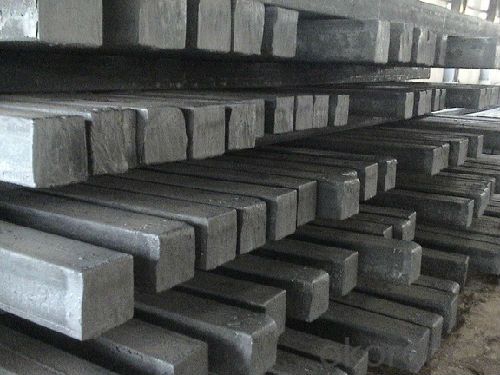
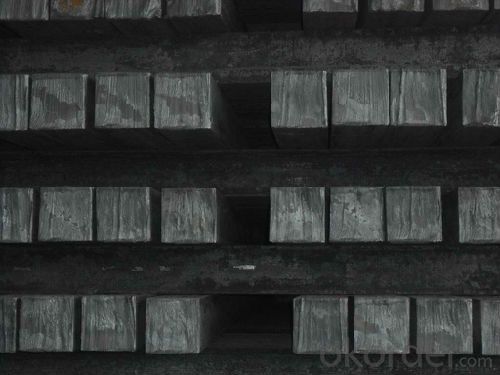
- Q: What are the different surface treatment methods used for steel billets?
- Steel billets undergo various surface treatment methods to enhance their properties and optimize their performance. Some commonly employed techniques include: 1. Pickling: By immersing steel billets in an acid bath, typically hydrochloric or sulfuric acid, any scale or oxides on the surface are effectively removed. This method improves surface finish and prepares billets for subsequent processing. 2. Shot blasting: High-velocity steel shots are used to subject steel billets to remove rust, scale, or contaminants from the surface. This method not only cleans the surface but also enhances its roughness, facilitating better adhesion of coatings or paints. 3. Phosphating: Applying a phosphate coating chemically onto the surface of steel billets is known as phosphating. This coating provides corrosion resistance and enhances paint adhesion. Phosphating is commonly employed as a pre-treatment method before applying organic coatings. 4. Galvanizing: A widely-used surface treatment method involves coating steel billets with a layer of zinc, known as galvanizing. This process ensures excellent corrosion resistance and safeguards the steel against environmental factors. Galvanized steel billets find extensive use in outdoor applications and industries where rust prevention is crucial. 5. Electroplating: Electroplating involves depositing a thin layer of metal, such as chromium or nickel, onto the surface of steel billets using an electric current. This method enhances aesthetic appearance, corrosion resistance, and wear resistance of the steel billets. 6. Coating: To provide a protective layer on the surface of steel billets, coating techniques such as painting, varnishing, or applying protective coatings are utilized. These coatings act as a barrier against corrosion, abrasion, and other forms of damage. Coatings can be applied using methods like spraying, dipping, or powder coating. 7. Passivation: Passivation is a chemical process employed to eliminate free iron and other contaminants from the surface of steel billets. This process aids in restoring the steel's passive film, which enhances corrosion resistance. Passivation is commonly employed in stainless steel billets to augment their resistance to rust and corrosion. These surface treatment methods significantly contribute to improving the quality, durability, and performance of steel billets, rendering them suitable for diverse applications across industries such as construction, automotive, and manufacturing.
- Q: What are the environmental impacts of steel billet production?
- The environmental impacts of steel billet production include air pollution from emissions of greenhouse gases and particulate matter, water pollution from the discharge of wastewater containing heavy metals and other pollutants, and deforestation and habitat destruction due to the extraction of raw materials such as iron ore and coal. Additionally, the energy-intensive nature of steel production contributes to significant carbon dioxide emissions, contributing to climate change. Efforts are being made to reduce these impacts through technological advancements and the adoption of more sustainable practices.
- Q: What are the main challenges in the recycling of steel billets?
- Several challenges arise when it comes to recycling steel billets, which are semi-finished steel products. The recycling process of steel billets includes several main challenges: 1. Contamination: Throughout their usage, steel billets can become contaminated with various materials such as oil, grease, paint, or other metals. Removing these contaminants and ensuring the purity of the recycled steel can be a complex and costly process. 2. Sorting and segregation: Steel billets come in different grades and sizes, requiring them to be sorted and segregated accordingly for effective recycling. This necessitates advanced sorting technologies and manual labor to ensure that the correct billets are recycled in the appropriate manner. 3. Energy consumption: The recycling of steel billets involves melting and reprocessing the steel, which demands a significant amount of energy. This energy consumption presents a challenge as it contributes to greenhouse gas emissions and increases the overall environmental impact of the recycling process. 4. Infrastructure and logistics: The collection, transportation, and processing of steel billets necessitate a well-established infrastructure and logistics network. Insufficient facilities or transportation can impede the efficient recycling of steel billets. 5. Economic viability: The economic viability of recycling steel billets can be challenging, especially when the cost of recycling exceeds the value of the recycled material. This can discourage recycling efforts and lead to a greater reliance on primary steel production. 6. Consumer awareness and participation: It is crucial to educate consumers about the importance of recycling steel billets and encourage their participation in recycling programs. Lack of awareness and indifference towards recycling can hinder the collection of steel billets for recycling purposes. 7. International trade barriers: In certain cases, trade barriers and import/export restrictions can affect the recycling of steel billets. These barriers can limit the flow of recycled steel billets across different countries, impacting the overall recycling capacity and market dynamics. To address these challenges, a collaborative effort between industries, governments, and consumers is necessary. Investments in research and development, technological advancements, and policy support can help overcome these challenges and promote the sustainable recycling of steel billets.
- Q: How do steel billets contribute to sustainable construction?
- Steel billets contribute to sustainable construction in several ways: 1. Reduced energy consumption: Steel billets are produced using electric arc furnaces, which require less energy compared to traditional steel manufacturing processes. This results in lower greenhouse gas emissions, contributing to the reduction of carbon footprint. 2. Recyclability: Steel is one of the most recycled materials in the world, and steel billets can be recycled multiple times without losing their mechanical properties. This reduces the need for new steel production, conserves natural resources, and decreases waste disposal. 3. Strength and durability: Steel billets have high strength and durability, making them an ideal choice for constructing sustainable buildings. Their structural integrity ensures long-lasting construction, reducing the need for frequent repairs or replacements. This helps to minimize waste generation and increase the lifespan of buildings. 4. Versatility: Steel billets can be shaped and formed into various structural components, allowing for flexibility in design and construction. This adaptability facilitates the construction of sustainable buildings that can be easily modified or expanded to accommodate changing requirements, reducing the need for new construction. 5. Resistance to natural disasters: Steel billets offer excellent resistance to seismic forces, hurricanes, and other natural disasters. This makes them suitable for constructing buildings in regions prone to such events, contributing to the resilience and safety of the built environment. 6. Reduced construction time: Steel billets enable faster construction due to their prefabricated nature. This reduces the overall construction time, minimizing disruption to the environment and nearby communities. Additionally, prefabricated steel components can be easily dismantled and reused, further enhancing sustainability. In conclusion, steel billets contribute to sustainable construction by reducing energy consumption, being highly recyclable, providing strength and durability, offering design versatility, resisting natural disasters, and reducing construction time. By incorporating steel billets into construction projects, we can create more environmentally-friendly and long-lasting structures, promoting sustainability in the built environment.
- Q: What are the different grades of steel used for making billets?
- There are several different grades of steel used for making billets, including low carbon steel, mild steel, medium carbon steel, high carbon steel, and alloy steel. The specific grade chosen depends on the desired properties and characteristics required for the intended application of the billets.
- Q: How are steel billets used in the production of structural steel sections?
- Steel billets play a crucial role in the manufacturing of structural steel sections, serving as the primary raw material. Initially, the billets are melted in a furnace to produce molten steel. The molten steel is then shaped into billets of specific sizes and shapes, which can vary depending on the desired structural steel section. Typically, the billets are rectangular or square. After solidification, the steel billets are reheated in another furnace to a specific temperature for the process of hot rolling. Hot rolling involves passing the billets through rolling mills to reduce their cross-sectional area and shape them into the desired structural steel sections. This process involves applying high pressure and temperature, causing the billets to deform and elongate. Subsequently, the hot rolled steel sections are cooled and undergo further processing, including straightening, cutting, and sometimes additional heat treatment to enhance their mechanical properties. These steps ensure that the structural steel sections meet the required specifications for strength, durability, and dimensional accuracy. The structural steel sections produced from steel billets are widely utilized in various construction projects. They are commonly employed in the construction of buildings, bridges, infrastructure, and other structures where strength and load-bearing capacity are crucial. These sections can be found in beams, columns, channels, angles, and other shapes, providing the necessary support and structural integrity. In conclusion, steel billets are of utmost importance in the production of structural steel sections. They serve as the starting material that undergoes a series of manufacturing processes to create the final products used in construction and other industries.
- Q: How are steel billets used in the manufacturing of rail tracks?
- Steel billets are an essential component in the manufacturing of rail tracks. A billet is a semi-finished piece of steel that is commonly used as a starting material in various metalworking processes. In the case of rail track manufacturing, steel billets are first heated to a high temperature and then passed through a series of rolling mills. During the rolling process, the steel billets are gradually shaped and elongated to form long, narrow sections known as rail blooms. These rail blooms are then further processed and shaped through hot rolling, where they are passed through multiple sets of rollers to achieve the desired dimensions and shape of the rail track. This process helps in improving the mechanical properties of the steel, such as its strength and durability. Once the rail blooms are shaped, they undergo a process called controlled cooling, where they are cooled at a specific rate to optimize their microstructure and properties. This controlled cooling helps in reducing internal stresses and improving the overall quality of the rail tracks. After the controlled cooling process, the rail blooms are further processed through straightening, cutting, and finally, finishing operations. These operations ensure that the rail tracks are straight, have precise dimensions, and meet the required standards and specifications. In summary, steel billets play a crucial role in the manufacturing of rail tracks. They are transformed into rail blooms through a series of rolling processes, and then further processed to produce high-quality rail tracks that are strong, durable, and able to withstand the heavy loads and constant use of railway transportation systems.
- Q: What are the main surface finishes available for steel billets?
- The main surface finishes available for steel billets include hot rolled, cold rolled, and coated finishes.
- Q: What are the main challenges in manufacturing steel billets?
- The main challenges in manufacturing steel billets include ensuring consistent quality and uniformity, managing the high temperatures involved in the process, maintaining efficient production rates, minimizing material waste, and addressing environmental concerns related to energy consumption and emissions. Additionally, ensuring the safety of workers and implementing effective maintenance practices are important challenges in the manufacturing of steel billets.
- Q: Can steel billets be used in the production of sculptures and artwork?
- Yes, steel billets can be used in the production of sculptures and artwork. Steel is a versatile and malleable material that allows artists to create unique and intricate designs. The use of steel billets in sculptures and artwork offers durability, strength, and the potential for large-scale installations. Artists can shape, weld, and manipulate steel billets to create a wide range of sculptures, from abstract forms to figurative representations. The industrial aesthetic of steel can also add a contemporary and bold element to the artwork. Additionally, steel can be finished with various techniques such as painting, patina, or polishing, allowing artists to further enhance their creative vision. Overall, steel billets present an exciting opportunity for artists to explore and push the boundaries of their artistic expression.
Send your message to us
Steel Billet Square with High Quality and Competitive Prices for Sale
- Loading Port:
- Tianjin
- Payment Terms:
- TT or LC
- Min Order Qty:
- 100 m.t.
- Supply Capability:
- 10000 m.t./month
OKorder Service Pledge
OKorder Financial Service
Similar products
Hot products
Hot Searches
Related keywords




